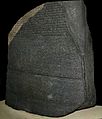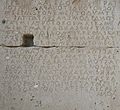Epigraphy facts for kids
Epigraphy is like being a detective for old writings! It's the study of words, symbols, and pictures carved or written on things that aren't paper. Think of messages left on rocks, clay tablets, stone buildings, or even metal objects. These writings are called inscriptions, and they help us learn about history, ancient languages, and how people lived long, long ago.
Contents
What is Epigraphy?
Epigraphy is the study of inscriptions. An inscription is any kind of writing that is carved, scratched, or painted onto a durable surface. These surfaces are usually not paper. Instead, they can be stone, metal, wood, clay, or even bone.
Finding Ancient Messages
Epigraphers, the people who study epigraphy, look for these hidden messages. They carefully examine the writing style, the tools used, and the language. This helps them understand when and why the inscription was made. It's like piecing together clues from the past.
Why is Epigraphy Important?
Studying inscriptions is super important for understanding history. Many ancient civilizations didn't have paper or books like we do today. They wrote important messages on things that would last a long time.
Learning About Old Languages
Inscriptions often show us how ancient languages were written. Sometimes, these languages are no longer spoken. The famous Rosetta Stone is a great example. It had the same message written in three different scripts. This helped experts finally understand ancient Egyptian hieroglyphs.
Discovering History and Culture
Inscriptions can tell us about kings, laws, religious beliefs, and daily life. They might record important events like battles or the building of temples. They can even show us how people thought and felt thousands of years ago. Without epigraphy, much of ancient history would still be a mystery.
Where Do We Find Inscriptions?
Inscriptions are found all over the world, on many different types of objects and structures.
On Buildings and Monuments
Many ancient buildings, like temples and tombs, have inscriptions. These might be dedications to gods or records of who built them. Statues and monuments often have names or important dates carved into their bases.
On Everyday Objects
Inscriptions aren't just on big monuments. They can be found on smaller items too. This includes pottery, coins, jewelry, and tools. These everyday objects give us clues about how ordinary people lived. For example, a name on a pot might tell us who owned it.
Different Types of Inscriptions
- Religious Inscriptions: Prayers, blessings, or stories about gods.
- Legal Inscriptions: Laws, treaties, or rules for a community.
- Funerary Inscriptions: Messages on tombstones, remembering the dead.
- Votive Inscriptions: Offerings made to gods or spirits.
- Historical Inscriptions: Records of important events or rulers.
Images for kids
-
The Rosetta Stone in the British Museum
-
Inscription on the pedestal of the statue of Michel Ney from Paris
-
Sanskrit incscribed on Brihadeshwara temple, Thanjavur, India.
-
Arabesque epigraphy with various Maghrebi Arabic scripts in the Myrtle Court of the Alhambra.
-
The high medieval Prüfening dedicatory inscription, composed in Latin and stamped in Roman square capitals
-
Ostrakon of Megacles, son of Hippocrates (inscription: ΜΕΓΑΚΛΕΣ ΗΙΠΠΟΚΡΑΤΟΣ), 487 BC. On display in the Ancient Agora Museum in Athens, housed in the Stoa of Attalus
-
An inscription using cipher runes, the Elder Futhark, and the Younger Futhark, on the 9th-century Rök runestone in Sweden
-
Roman marble funeral stele with inscription: "CIL VI 23414: D(is) M(anibus) / M(arco) Ogulnio / Iusto filio / pientissimo / vix(it) ann(os) XV mens(es) II d(ies) XXII / M(arcus) Ogulnius / Iustus pater / et sibi fecit" – 1st century AD
-
Inscription on a Roman mosaic from excavations in the Appian Way, Rome. The Greek motto gnōthi sauton ("know thyself", nosce te ipsum) combines with the image to convey the famous warning: Respice post te; hominem te esse memento; memento mori (Look behind; remember that you are mortal; remember death)
-
Bust of Periander bearing the inscription "Periander, son of Cypselus, Corinthian". Marble, Roman copy after a Greek original by Kresilas, 4th century
-
The ancient bronze Serpent Column at the Hippodrome of Constantinople. The Obelisk of Theodosius is seen in the background.
See also
 In Spanish: Epigrafía para niños
In Spanish: Epigrafía para niños



















